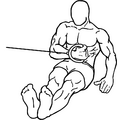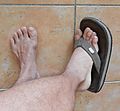Adduction facts for kids
Adduction is a form of movement in animal biology which brings a part of the anatomy closer to the sagittal plane of the body. The opposite of adduction is abduction.
Muscles of adduction
Upper limb
- of arm at shoulder (lowering arm)
- Subscapularis
- Teres major
- Pectoralis major
- Infraspinatus
- Triceps brachii (caput longum)
- Latissimus dorsi
- Coracobrachialis
- of fingers
- Palmar interossei
- of thumb
- Adductor pollicis
Lower limb
- of thigh at hip
- medial compartment of thigh/adductor muscles of the hip
- Adductor longus
- Adductor brevis
- Adductor magnus
- Pectineus
- Gracilis
- medial compartment of thigh/adductor muscles of the hip
- of toes (S2-S3)
- Adductor hallucis
- Plantar interossei
Other
- vocal folds
- Lateral cricoarytenoid muscle
- eyeball
- Superior rectus muscle
- Inferior rectus muscle
- Medial rectus muscle
Adduction in Scallops
Scallops have a central adductor muscle. It lets them open and close their shells. It is quite large and developed compared to other bivalves because they swim a lot.
Images for kids
-
The lotus position of yoga, demonstrating external rotation of the leg at the hip.
-
The swinging action made during a tennis serve is an example of circumduction
-
A ballerina, demonstrating plantar flexion of the feet
-
Praying Hands by Albrecht Dürer, demonstrating dorsiflexion of the hands.

All content from Kiddle encyclopedia articles (including the article images and facts) can be freely used under Attribution-ShareAlike license, unless stated otherwise. Cite this article:
Adduction Facts for Kids. Kiddle Encyclopedia.



















